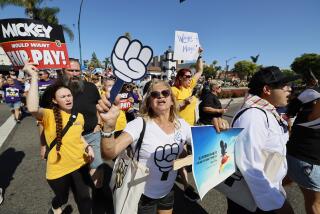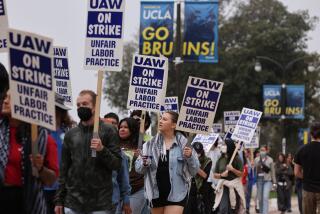Strike Violence Condemned by Home Builders
- Share via
SANTA ANA — Southern California’s home builders Friday denounced the violence and vandalism in a six-week-old walkout by several thousand drywall workers while 250 of the strikers, their wives and children protested outside.
The home builders’ powerful trade group, the Building Industry Assn. of Southern California, had kept a low profile in the bitter dispute. But Friday morning at its Orange County headquarters in Santa Ana, the builders group showed a videotape of what it said were drywall workers smashing windows of half-finished houses in mid-June at a Kathryn G. Thompson Development Co. housing tract in the South County community of Aliso Viejo.
A copy of the tape was turned over to sheriff’s deputies, said Michael J. Rafferty, president of the home-building company. The incident was typical, he said, of outbreaks of vandalism in the past few weeks.
But the striking drywallers, all Mexican immigrants, said Friday that the builders are using the vandalism to divert attention from the economic issues in the strike.
More than 1,000 drywall workers across Southern California walked off the job June 1 demanding wages higher than the $300 a week they say many of them receive now. They say they have not had a raise in 10 years.
The strike has been successful in keeping many of the region’s estimated 4,000 drywall hangers off the job, shutting down scattered construction sites from Ventura County to the Mexican border.
The men also want health benefits--most have none now--and insist on a union to guarantee any gains.
Separately, the federal Immigration and Naturalization Service said late Friday afternoon that it had in custody 74 of the 153 strikers arrested for trespassing in Mission Viejo last week and was preparing to deport some of them to Mexico. INS agents were interviewing the men to determine, among other things, the names of their employers.
But as many as 23 of those detained, the INS said, may turn out to be in the country legally; some of them had already been released Friday afternoon. They had finally produced green cards, the INS said, or showed proof of pending applications for U.S. citizenship.
Another dozen men whom the INS says may be illegal immigrants have yet to be taken into INS custody.
Some of the 74 will probably post bond and be released over the weekend, said John Brechtel, assistant district director for investigations for the INS in Los Angeles. The others will be held in federal jails.
Lawyers for the men charge that the INS is letting itself be used to break the strike; the immigration agency says it is merely enforcing the law.
The INS says it may get enough information from the men to seek fines or criminal charges against their employers, although such cases are often hard to make. Better information, the INS said, usually comes from disgruntled employees, who often say they have been replaced by illegal immigrants and have proof that their employers knowingly hired undocumented workers.
The men and some of their lawyers contend that they were rousted by sheriff’s deputies in the mass arrest in Mission Viejo in order to break the strike at the behest of politically influential builders and developers; prosecutors say the men were on a dangerous rampage, smashing drywall and intimidating fellow drywall hangers who continue to work.
The builders, meanwhile, said Friday they were open to discussions with the drywall workers if the violence ceases. But, they concede, most of the trade group’s members remain adamantly opposed to dealing with unions. And they are not likely to change their minds, the builders say, which means that any solution to the walkout that involves a union remains distant.
Builders also displayed two large rocks they said had been thrown through the windshield of a drywall company foreman’s pickup truck in Colton a few days ago. And they played an answering machine message, purportedly received by the same foreman, on which a voice repeatedly whispers, “Fire . . . fire . . . fire in your house.”
“This is not a union issue,” said O. Randolph Hall Jr., a San Bernardino home builder and president of the regional trade association. “It’s a crime and violence issue.”
At noon, about an hour into the press conference, shouts of “Si, Se Puede!”--”Yes, It Can Be Done!”--could be heard from the second-floor offices of the Orange County Building Industry Assn. on Fourth Street in Santa Ana.
Startled BIA employees looked out their windows to see drywall workers circling the building in a picket line. The BIA already had at least two private security guards on duty just for the press conference; Santa Ana police showed up a few minutes later and stayed for about an hour and 20 minutes until the protesters left. The BIA, meanwhile, hastily concluded its press conference.
The workers then went to a carpenters’ union hall in Orange for a donated meal of beans, tortillas and potatoes. The men say donations of food and money have poured in, with the amounts increasing as the strike draws more publicity.
The builders also took pains at Friday’s press conference to distance themselves from the drywall subcontractors, who directly employ the striking men.
In a statement, the BIA said it favors “a fair and equitable wage for drywall workers” but did not specify how that was to be achieved.
Drywall is nailed in half-inch-thick sheets onto wooden frames to form the inner walls of houses. Hanging the material is said to be one of the most physically taxing jobs in the building industry.
The BIA also said it “does not condone the hiring of undocumented workers, paying workers in cash or another means to subvert employee benefit laws, nor does it condone the use of ‘labor barons,’ ” usually Latino, who as foremen exploit the men under them.
The BIA Friday confirmed one point the drywall workers have been making: that wages haven’t risen in 10 years. But one reason, the BIA said, is because today’s workers are less productive than those of a few years ago. “Lower productivity,” the group said in a statement, “has also led to a decline in effective weekly wages.”
Many drywall companies say they have had to squeeze wages because, in the non-union 1980s, cutthroat competition broke out among them. As a result, companies had to submit ever lower bids to survive. Some also say they would consider a union contract if the builders would agree not to use cheaper non-union subcontractors.
It may be hard times for builders now, the workers and the drywall companies say, but the builders had very good years when the housing market boomed in the mid-1980s. The drywall workers and the drywall companies, they say, did not share in that prosperity.
The builders take a different stance.
“We really think this is a subcontractor issue,” said Hall, the BIA leader who is also president of Concordia Homes.
More to Read
Inside the business of entertainment
The Wide Shot brings you news, analysis and insights on everything from streaming wars to production — and what it all means for the future.
You may occasionally receive promotional content from the Los Angeles Times.










